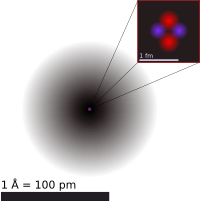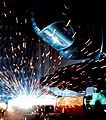Particle facts for kids

Particles are super tiny bits of matter that make up everything around us. Think of them as the smallest building blocks of the universe! In particle physics, an elementary particle is a particle that cannot be broken down into even smaller pieces.
There are many different kinds of particles. They come in various sizes and have unique features.
Some particles are big enough to see! We call these macroscopic particles. They are larger than atoms or molecules. Things like powder and dust are good examples. They have their own shape and take up space. Nanoparticles are tiny powders, but still much bigger than atoms.
Microscopic particles are so small you need a powerful microscope to see them. Atoms and molecules are examples of these. Molecules are made when two or more atoms join together.
Even smaller than atoms are subatomic particles. These are the tiny parts that make up an atom. The main subatomic particles are the proton, the neutron, and the electron.
- Protons have a positive electric charge. We often call this a + charge.
- Neutrons have no electric charge. They are neutral.
- Electrons have a negative electric charge. We call this a - charge. Electrons are the smallest of these three particles.
Inside every atom, there's a tiny center called the nucleus. This is where the protons and neutrons live. Electrons are always moving around the nucleus, like tiny planets orbiting a star.
Protons and neutrons are made of even smaller particles called quarks. Scientists believe quarks are elementary particles, meaning they might be the smallest things we know! There are six different types of quarks: the up quark, the down quark, the strange quark, the charm quark, the bottom quark, and the top quark. A neutron is made of two down quarks and one up quark. A proton is made of two up quarks and one down quark.
What are particles made of?
- Everything in the world is made up of particles.
- There are different types of particles, depending on their size and features.
- Macroscopic particles are large enough to see with your eyes, like powder and dust.
- Atoms and molecules are microscopic particles. They are so tiny that you need very strong microscopes to see them. Molecules are built from atoms.
- Atoms are made of subatomic particles: protons, neutrons, and electrons.
- Protons and neutrons are made of quarks. Scientists are still studying if quarks are made of even smaller particles.
Particles and states of matter
The way particles are arranged affects whether something is a solid, liquid, or gas.
- In a solid, particles are packed very close together. There is not much space between them.
- In a liquid, particles have a bit more space. They can slide past each other.
- In a gas, particles have lots of space. They fly around freely.
Because there's so much space between particles in liquids and gases, other objects can easily move through them. Think about swimming through water (a liquid) or walking through air (a gas)!
Things can change from a gas to a liquid or a solid. This happens when the temperature or pressure changes. A great example is water. It can be a gas (like vapor in the air), a liquid (what you drink), or a solid (ice).
Images for kids
-
Arc welders need to protect themselves from welding sparks, which are heated metal particles that fly off the welding surface.
See also
 In Spanish: Partícula (física) para niños
In Spanish: Partícula (física) para niños




